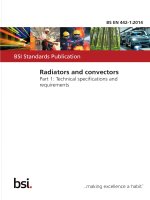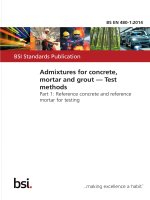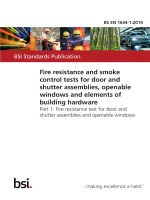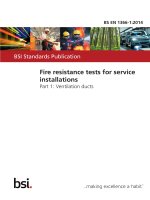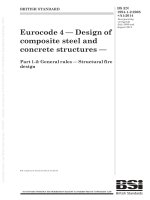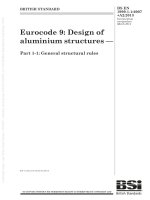Bsi bs en 61675 1 2014
Bạn đang xem bản rút gọn của tài liệu. Xem và tải ngay bản đầy đủ của tài liệu tại đây (1.4 MB, 44 trang )
BS EN 61675-1:2014
BSI Standards Publication
Radionuclide imaging
devices — Characteristics
and test conditions
Part 1: Positron emission tomographs
BRITISH STANDARD
BS EN 61675-1:2014
National foreword
This British Standard is the UK implementation of EN 61675-1:2014. It is
identical to IEC 61675-1:2013. It supersedes BS EN 61675-1:1998+A1:2008
which is withdrawn.
The UK participation in its preparation was entrusted by Technical Committee CH/62, Electrical Equipment in Medical Practice, to Subcommittee
CH/62/3, Equipment for radiotherapy, nuclear medicine and radiation
dosimetry.
A list of organizations represented on this committee can be obtained on
request to its secretary.
This publication does not purport to include all the necessary provisions of
a contract. Users are responsible for its correct application.
© The British Standards Institution 2014.
Published by BSI Standards Limited 2014
ISBN 978 0 580 76378 6
ICS 11.040.50; 35.240.80
Compliance with a British Standard cannot confer immunity from
legal obligations.
This British Standard was published under the authority of the
Standards Policy and Strategy Committee on 31 July 2014.
Amendments/corrigenda issued since publication
Date
Text affected
BS EN 61675-1:2014
EUROPEAN STANDARD
EN 61675-1
NORME EUROPÉENNE
EUROPÄISCHE NORM
June 2014
ICS 11.040.50
Supersedes EN 61675-1:1998
English Version
Radionuclide imaging devices - Characteristics and test
conditions - Part 1: Positron emission tomographs
(IEC 61675-1:2013)
Dispositifs d'imagerie par radionucléides - Caractéristiques
et conditions d'essai - Partie 1: Tomographes à émission de
positrons
(CEI 61675-1:2013)
Bildgebende Systeme in der Nuklearmedizin - Merkmale
und Prüfbedingungen - Teil 1: Positronen-EmissionsTomographen
(IEC 61675-1:2013)
This European Standard was approved by CENELEC on 2013-10-30. CENELEC members are bound to comply with the CEN/CENELEC
Internal Regulations which stipulate the conditions for giving this European Standard the status of a national standard without any alteration.
Up-to-date lists and bibliographical references concerning such national standards may be obtained on application to the CEN-CENELEC
Management Centre or to any CENELEC member.
This European Standard exists in three official versions (English, French, German). A version in any other language made by translation
under the responsibility of a CENELEC member into its own language and notified to the CEN-CENELEC Management Centre has the
same status as the official versions.
CENELEC members are the national electrotechnical committees of Austria, Belgium, Bulgaria, Croatia, Cyprus, the Czech Republic,
Denmark, Estonia, Finland, Former Yugoslav Republic of Macedonia, France, Germany, Greece, Hungary, Iceland, Ireland, Italy, Latvia,
Lithuania, Luxembourg, Malta, the Netherlands, Norway, Poland, Portugal, Romania, Slovakia, Slovenia, Spain, Sweden, Switzerland,
Turkey and the United Kingdom.
European Committee for Electrotechnical Standardization
Comité Européen de Normalisation Electrotechnique
Europäisches Komitee für Elektrotechnische Normung
CEN-CENELEC Management Centre: Avenue Marnix 17, B-1000 Brussels
© 2014 CENELEC All rights of exploitation in any form and by any means reserved worldwide for CENELEC Members.
Ref. No. EN 61675-1:2014 E
BS EN 61675-1:2014
EN 61675-1:2014
-2-
Foreword
The text of document 62C/550/CDV, future edition 2 of IEC 61675-1, prepared by IEC/SC 62C,
"Equipment for radiotherapy, nuclear medicine and radiation dosimetry", of IEC TC 62, "Electrical
equipment in medical practice " was submitted to the IEC-CENELEC parallel vote and approved by
CENELEC as EN 61675-1:2014.
The following dates are fixed:
•
•
latest date by which the document has
to be implemented at national level by
publication of an identical national
standard or by endorsement
latest date by which the national
standards conflicting with the
document have to be withdrawn
(dop)
2014-12-13
(dow)
2016-10-30
This document supersedes EN 61675-1:1998.
Attention is drawn to the possibility that some of the elements of this document may be the subject of
patent rights. CENELEC [and/or CEN] shall not be held responsible for identifying any or all such patent
rights.
Endorsement notice
The text of the International Standard IEC 61675-1:2013 was approved by CENELEC as a European
Standard without any modification.
BS EN 61675-1:2014
EN 61675-1:2014
-3-
Annex ZA
(normative)
Normative references to international publications
with their corresponding European publications
The following documents, in whole or in part, are normatively referenced in this document and are
indispensable for its application. For dated references, only the edition cited applies. For undated
references, the latest edition of the referenced document (including any amendments) applies.
NOTE When an international publication has been modified by common modifications, indicated by (mod), the relevant EN/HD
applies.
Publication
Year
Title
EN/HD
Year
IEC/TR 60788
2004
Medical electrical equipment - Glossary of
defined terms
-
-
–2–
BS EN 61675-1:2014
61675-1 © IEC:2013
CONTENTS
INTRODUCTION ..................................................................................................................... 6
1
Scope .............................................................................................................................. 7
2
Normative references ...................................................................................................... 7
3
Terms and definitions ...................................................................................................... 7
4
Test methods ................................................................................................................. 13
4.1
4.2
5
General ............................................................................................................ 13
S PATIAL RESOLUTION ......................................................................................... 13
4.2.1
General .......................................................................................... 13
4.2.3
Method ........................................................................................... 14
4.2.4
Analysis .......................................................................................... 15
4.2.5
Report ............................................................................................ 17
4.3
Tomographic sensitivity.................................................................................... 18
4.3.1
General .......................................................................................... 18
4.3.2
Purpose .......................................................................................... 18
4.3.3
Method ........................................................................................... 18
4.3.4
Analysis .......................................................................................... 19
4.3.5
Report ............................................................................................ 20
4.4
Uniformity ........................................................................................................ 20
4.5
Scatter measurement ....................................................................................... 20
4.5.1
General .......................................................................................... 20
4.5.2
Purpose .......................................................................................... 20
4.5.3
Method ........................................................................................... 20
4.5.4
Analysis .......................................................................................... 21
4.5.5
Report ............................................................................................ 22
4.6
PET COUNT RATE PERFORMANCE ........................................................................ 23
4.6.1
General .......................................................................................... 23
4.6.2
Purpose .......................................................................................... 23
4.6.3
Method ........................................................................................... 23
4.6.4
Analysis .......................................................................................... 24
4.6.5
Report ............................................................................................ 26
4.7
Image quality and quantification accuracy of source ACTIVITY
concentrations ................................................................................................. 26
4.7.1
General .......................................................................................... 26
4.7.2
Purpose .......................................................................................... 26
4.7.3
Method ........................................................................................... 27
4.7.4
Data analysis .................................................................................. 31
4.7.5
Report ............................................................................................ 34
A CCOMPANYING DOCUMENTS ............................................................................................ 35
5.1
5.2
5.3
5.4
5.5
5.6
5.7
General ............................................................................................................ 35
Design parameters ........................................................................................... 35
Configuration of the tomograph ........................................................................ 36
S PATIAL RESOLUTION ......................................................................................... 36
Sensitivity ........................................................................................................ 36
S CATTER FRACTION ............................................................................................ 36
C OUNT RATE performance ................................................................................. 36
BS EN 61675-1:2014
61675-1 © IEC:2013
–3–
5.8
Image quality and quantification accuracy of source ACTIVITY
concentrations ................................................................................................. 36
Bibliography .......................................................................................................................... 37
Index of defined terms .......................................................................................................... 38
Figure 1 – Evaluation of FWHM ............................................................................................ 16
Figure 2 – Evaluation of EQUIVALENT WIDTH ( EW ) .................................................................... 17
Figure 3 – Scatter phantom configuration and position on the imaging bed ........................... 19
Figure 4 – Evaluation of SCATTER FRACTION ........................................................................... 22
Figure 5 – Cross-section of body phantom ............................................................................ 27
Figure 6 – Phantom insert with hollow spheres ..................................................................... 28
Figure 7 – Image quality phantom and scatter phantom position for whole body scan
acquisition ............................................................................................................................ 29
Figure 8 – Placement of ROIs in the phantom background .................................................... 32
–6–
BS EN 61675-1:2014
61675-1 © IEC:2013
INTRODUCTION
Further developments of POSITRON EMISSION TOMOGRAPHS allow most of the tomographs to be
operated in fully 3D acquisition mode. To comply with this trend, this standard describes test
conditions in accordance with this acquisition characteristic. In addition, today a POSITRON
EMISSION TOMOGRAPH often includes X- RAY EQUIPMENT for COMPUTED TOMOGRAPHY (CT). For
this standard PET-CT hybrid devices are considered to be state of the art, dedicated
POSITRON EMISSION TOMOGRAPHS not including the X-ray component being special cases only.
The test methods specified in this part of IEC 61675 have been selected to reflect as much as
possible the clinical use of POSITRON EMISSION TOMOGRAPHS . It is intended that the tests be
carried out by MANUFACTURERS , thereby enabling them to declare the characteristics of
POSITRON EMISSION TOMOGRAPHS in the ACCOMPANYING DOCUMENTS . This standard does not
indicate which tests will be performed by the MANUFACTURER on an individual tomograph.
BS EN 61675-1:2014
61675-1 © IEC:2013
–7–
RADIONUCLIDE IMAGING DEVICES –
CHARACTERISTICS AND TEST CONDITIONS –
Part 1: Positron emission tomographs
1
Scope
This part of IEC 61675 specifies terminology and test methods for declaring the
characteristics of POSITRON EMISSION TOMOGRAPHS . P OSITRON EMISSION TOMOGRAPHS detect the
ANNIHILATION RADIATION of positron emitting RADIONUCLIDE s by COINCIDENCE DETECTION .
No test has been specified to characterize the uniformity of reconstructed images, because all
methods known so far will mostly reflect the noise in the image.
2
Normative references
The following documents, in whole or in part, are normatively referenced in this document and
are indispensable for its application. For dated references, only the edition cited applies. For
undated references, the latest edition of the referenced document (including any
amendments) applies.
IEC 60788:2004, Medical electrical equipment – Glossary of defined terms
3
Terms and definitions
For the purposes of this document, the terms and definitions given in IEC 60788:2004 and the
following apply.
3.1
tomography
radiography of one or more layers within an object
[SOURCE: IEC 60788:2004, rm-41-15]
3.1.1
transverse tomography
TOMOGRAPHY that slices a three-dimensional object into a stack of OBJECT SLICES which are
considered as being two-dimensional and independent from each other and at which the
IMAGE PLANES are perpendicular to the SYSTEM AXIS
3.1.2
emission computed tomography
ECT
imaging method for the representation of the spatial distribution
RADIONUCLIDES in selected two-dimensional slices through the object
of
incorporated
3.1.2.1
projection
transformation of a three-dimensional object into its two-dimensional image or of a twodimensional object into its one-dimensional image, by integrating the physical property which
determines the image along the direction of the PROJECTION BEAM
–8–
BS EN 61675-1:2014
61675-1 © IEC:2013
Note 1 to entry: This process is mathematically described by line integrals in the direction of PROJECTION (along
the LINE OF RESPONSE ) and called radon-transform.
3.1.2.2
projection beam
beam that determines the smallest possible volume in which the physical property which
determines the image is integrated during the measurement process
Note 1 to entry:
Its shape is limited by SPATIAL RESOLUTION in all three dimensions.
Note 2 to entry: The PROJECTION BEAM mostly has the shape of a long thin cylinder or cone. In POSITRON EMISSION
TOMOGRAPHY , it is the sensitive volume between two detector elements operated in coincidence.
3.1.2.3
projection angle
angle at which the PROJECTION is measured or acquired
3.1.2.4
sinogram
two-dimensional display of all one-dimensional PROJECTION s of an OBJECT SLICE , as a function
of the PROJECTION ANGLE
Note 1 to entry: The PROJECTION ANGLE is displayed on the ordinate, the linear projection coordinate is displayed
on the abscissa.
3.1.2.5
object slice
physical property that correspondes to a slice in the object and that determines the measured
information and which is displayed in the tomographic image
3.1.2.6
image plane
a plane assigned to a plane in the OBJECT SLICE
Note 1 to entry:
Usually the IMAGE PLANE is the midplane of the corresponding OBJECT SLICE .
3.1.2.7
system axis
axis of symmetry, characterized by geometrical and physical properties of the arrangement of
the system
Note 1 to entry: For a circular POSITRON EMISSION TOMOGRAPH , the SYSTEM AXIS is the axis through the centre of
the detector ring. For tomographs with rotating detectors it is the axis of rotation.
3.1.2.8
tomographic volume
juxtaposition of all volume elements which contribute to the measured PROJECTION s for all
PROJECTION ANGLES
3.1.2.8.1
transverse field of view
dimensions of a slice through the TOMOGRAPHIC VOLUME , perpendicular to the SYSTEM AXIS
Note 1 to entry:
For a circular TRANSVERSE FIELD OF VIEW , it is described by its diameter.
Note 2 to entry: For non-cylindrical TOMOGRAPHIC VOLUMES the TRANSVERSE FIELD OF VIEW may depend on the
axial position of the slice.
3.1.2.8.2
axial field of view
AFOV
field which is characterized by dimensions of a slice through the TOMOGRAPHIC VOLUME ,
parallel to and including the SYSTEM AXIS
BS EN 61675-1:2014
61675-1 © IEC:2013
–9–
Note 1 to entry: In practice, it is specified only by its axial dimension, given by the distance between the centre of
the outmost defined IMAGE PLANE s plus the average of the measured AXIAL RESOLUTION .
3.1.2.8.3
total field of view
field which is characterized by dimensions (three-dimensional) of the TOMOGRAPHIC VOLUME
3.1.3
positron emission tomography
PET
EMISSION COMPUTED TOMOGRAPHY utilizing
RADIONUCLIDES by COINCIDENCE DETECTION
3.1.3.1
positron emission tomograph
tomographic device, which detects the
RADIONUCLIDES by COINCIDENCE DETECTION
the ANNIHILATION RADIATION of positron emitting
ANNIHILATION
RADIATION
of
positron
emitting
3.1.3.2
annihilation radiation
ionizing radiation that is produced when a particle and its antiparticle interact and cease to
exist
3.1.3.3
coincidence detection
method which checks whether two opposing detectors have detected one photon each
simultaneously
Note 1 to entry:
By this method the two photons are concatenated into one event.
Note 2 to entry: The COINCIDENCE DETECTION between two opposing detector elements serves as an electronic
collimation to define the corresponding PROJECTION BEAM or LINE OF RESPONSE ( LOR ), respectively.
3.1.3.4
coincidence window
time interval during which two detected photons are considered as being simultaneous
3.1.3.5
line of response
LOR
axis of the PROJECTION BEAM
Note 1 to entry:
coincidence.
In PET, it is the line connecting the centres of two opposing detector elements operated in
3.1.3.6
total coincidences
sum of all coincidences detected
3.1.3.6.1
true coincidence
result of COINCIDENCE DETECTION of two gamma events originating from the same positron
annihilation
3.1.3.6.2
scattered true coincidence
TRUE COINCIDENCE where at least one participating photon was scattered before the
COINCIDENCE DETECTION
– 10 –
BS EN 61675-1:2014
61675-1 © IEC:2013
3.1.3.6.3
unscattered true coincidence
difference between TRUE COINCIDENCES and SCATTERED TRUE COINCIDENCES
3.1.3.6.4
random coincidence
result of a COINCIDENCE DETECTION in which participating photons do not originate from the
same positron annihilation.
3.1.3.7
singles rate
COUNT RATE measured without COINCIDENCE DETECTION , but with energy discrimination
3.1.4
two-dimensional reconstruction
image reconstruction at which data are rebinned prior to reconstruction into SINOGRAMS , which
are the PROJECTION data of transverse slices which are considered as being independent of
each other and being perpendicular to the SYSTEM AXIS
3.1.5
three-dimensional reconstruction
image reconstruction at which the LINES OF RESPONSE are not restricted to being perpendicular
to the SYSTEM AXIS so that a LINE OF RESPONSE may pass several transverse slices
3.2
image matrix
<nuclear medicine> matrix in which each element corresponds to the measured or calculated
physical property of the object at the location described by the coordinates of this MATRIX
ELEMENT
3.2.1
matrix element
smallest unit of an IMAGE MATRIX, which is assigned in location and size to a certain volume
element of the object ( VOXEL )
3.2.1.1
pixel
MATRIX ELEMENT
3.2.1.2
trixel
MATRIX ELEMENT
in a two-dimensional IMAGE MATRIX
in a three-dimensional IMAGE MATRIX
3.2.2
voxel
volume element in the object which is assigned to a MATRIX ELEMENT in a two- or threedimensional IMAGE MATRIX
Note 1 to entry: The dimensions of the VOXEL are determined by the dimensions of the corresponding MATRIX
ELEMENT via the appropriate scale factors and by the systems SPATIAL RESOLUTION in all three dimensions.
3.3
point spread function
PSF
scintigraphic image of a POINT SOURCE
BS EN 61675-1:2014
61675-1 © IEC:2013
– 11 –
3.3.1
physical point spread function
<tomographs> two-dimensional POINT SPREAD FUNCTION in planes perpendicular to the
PROJECTION BEAM at specified distances from the detector
Note 1 to entry: The PHYSICAL POINT SPREAD FUNCTION characterizes the purely physical (intrinsic) imaging
performance of the tomographic device and is independent of for example sampling, image reconstruction and
image processing. A PROJECTION BEAM is characterized by the entirety of all PHYSICAL POINT SPREAD FUNCTION s as a
function of distance along its axis.
3.3.2
axial point spread function
profile passing through the peak of the PHYSICAL POINT SPREAD FUNCTION in a plane parallel to
the s YSTEM AXIS
3.3.3
transverse point spread function
reconstructed two-dimensional POINT SPREAD FUNCTION in a tomographic IMAGE PLANE
Note 1 to entry: In TOMOGRAPHY , the TRANSVERSE POINT SPREAD FUNCTION can also be obtained from a LINE
located parallel to the SYSTEM AXIS .
SOURCE
3.4
spatial resolution
<nuclear medicine> ability to concentrate the count density distribution in the image of a POINT
SOURCE to a point
3.4.1
transverse resolution
SPATIAL RESOLUTION in a reconstructed plane perpendicular to the SYSTEM AXIS
3.4.1.1
radial resolution
TRANSVERSE RESOLUTION
SYSTEM AXIS
3.4.1.2
tangential resolution
TRANSVERSE RESOLUTION
3.4.2
axial resolution
SPATIAL RESOLUTION
along a line passing through the position of the source and the
in the direction orthogonal to the direction of RADIAL RESOLUTION
along a line parallel to the SYSTEM AXIS
Note 1 to entry: A XIAL RESOLUTION only applies for tomographs with sufficiently fine axial sampling fulfilling the
sampling theorem.
3.4.3
equivalent width
EW
width of the rectangle that has the same area and the same height as the response function
3.4.4
full width at half maximum
FWHM
for a bell shaped curve, distance parallel to the abscissa axis between the points where the
ordinate has half of its maximum value
[SOURCE: IEC 60788:2004, rm-73-02
– 12 –
BS EN 61675-1:2014
61675-1 © IEC:2013
3.5
recovery coefficient
measured (image) ACTIVITY concentration of an active volume divided by the true ACTIVITY
concentration of that volume, neglecting ACTIVITY calibration factors
Note 1 to entry: For the actual measurement, the true ACTIVITY concentration is replaced by the measured
ACTIVITY concentration in a large volume.
3.6
slice sensitivity
ratio of COUNT RATE as measured on the SINOGRAM to the ACTIVITY concentration in the
phantom
Note 1 to entry:
FRACTION .
In PET, the measured counts are numerically corrected for scatter by subtracting the SCATTER
3.7
volume sensitivity
sum of the individual SLICE SENSITIVITIES
3.8
count rate characteristic
function giving the relationship between observed COUNT RATE and TRUE COUNT RATE
[SOURCE: IEC 60788:2004, rm-34-21
3.8.1
count loss
difference between measured COUNT RATE and TRUE COUNT RATE , which is caused by the finite
RESOLVING TIME of the instrument
3.8.2
count rate
number of counts per unit of time
3.8.3
true count rate
COUNT RATE that would be observed if the RESOLVING TIME of the device were zero
[SOURCE: IEC 60788:2004, rm-34-20]
3.9
scatter fraction
SF
ratio between SCATTERED TRUE COINCIDENCES and the sum of SCATTERED plus UNSCATTERED
TRUE COINCIDENCES for a given experimental set-up
3.10
point source
RADIOACTIVE SOURCE
approximating a δ -function in all three dimensions
3.11
line source
straight RADIOACTIVE SOURCE approximating a δ -function in two dimensions and being constant
(uniform) in the third dimension
BS EN 61675-1:2014
61675-1 © IEC:2013
– 13 –
3.12
calibration
<emission computed tomography> the process to establish the relation between COUNT RATE
per volume element locally in the image and the corresponding ACTIVITY concentration in the
object for object sizes not requiring RECOVERY CORRECTION
Note 1 to entry: In order to have this CALIBRATION fairly independent of the object under study, the application of
proper corrections to the data, e.g. ATTENUATION , scatter, COUNT LOSS , radioactive decay, detector normalization,
RANDOM COINCIDENCES (PET), and branching ratio (PET) is mandatory. The independency of the object is required
to scale clinical images in terms of kBq/ml or standardized uptake values (SUV).
3.13
PET count rate performance
relationship between the measured COUNT RATE of TRUE COINCIDENCES , RANDOM COINCIDENCES ,
TOTAL COINCIDENCES , and noise equivalent count rate versus ACTIVITY
4
Test methods
4.1
General
For all measurements, the tomograph shall be set up according to its normal mode of
operation, i.e. it shall not be adjusted specially for the measurement of specific parameters. If
the tomograph is specified to operate in different modes influencing the performance
parameters, for example with different axial acceptance angles, with and without septa, with
TWO - DIMENSIONAL RECONSTRUCTION and THREE - DIMENSIONAL RECONSTRUCTION , the test results
shall be reported for every mode of operation. The tomograph configuration (e.g. energy
thresholds, axial acceptance angle, reconstruction algorithm) shall be chosen according to the
MANUFACTURER ’s recommendation and clearly stated. If any test cannot be carried out exactly
as specified in this standard, the reason for the deviation and the exact conditions under
which the test was performed shall be stated clearly.
It is postulated that a POSITRON EMISSION TOMOGRAPH is capable of measuring RANDOM
COINCIDENCES and performing the appropriate correction. In addition, a POSITRON EMISSION
TOMOGRAPH shall provide corrections for scatter, ATTENUATION , COUNT LOSS , branching ratio,
radioactive decay, and CALIBRATION .
The test phantoms shall be centred within the tomograph’s AXIAL FIELD OF VIEW , if not specified
otherwise.
4.2
4.2.1
S PATIAL RESOLUTION
General
S PATIAL RESOLUTION measurements describe partly the ability of a tomograph to reproduce the
spatial distribution of a tracer in an object in a reconstructed image. The measurement is
performed by imaging POINT SOURCES in air and reconstructing images, using a sharp
reconstruction filter. Although this does not represent the condition of imaging a PATIENT ,
where tissue scatter is present and limited statistics require the use of a smooth
reconstruction filter and/or iterative reconstruction methods, the measured SPATIAL
RESOLUTION provides an objective comparison between tomographs.
4.2.2
Purpose
The purpose of this measurement is to characterize the ability of the tomograph to recover
small objects.
The TRANSVERSE RESOLUTION is characterized by the width of the reconstructed TRANSVERSE
POINT SPREAD FUNCTIONS of radioactive POINT SOURCES . The width of the spread function is
measured by the FULL WIDTH AT HALF MAXIMUM (FWHM) and the EQUIVALENT WIDTH (EW).
– 14 –
BS EN 61675-1:2014
61675-1 © IEC:2013
The AXIAL RESOLUTION is defined for tomographs with sufficiently fine axial sampling (volume
detectors) and could be measured with a stationary POINT SOURCE . These systems (fulfilling
the sampling theorem in the axial direction) are characterized by the fact that the AXIAL POINT
SPREAD FUNCTION of a stationary POINT SOURCE would not vary if the position of the source is
varied in the axial direction for half the axial sampling distance.
4.2.3
4.2.3.1
Method
General
For all systems, the SPATIAL RESOLUTION shall be measured in the transverse IMAGE PLANE in
two directions (i.e. radially and tangentially). In addition, for those systems having sufficiently
fine axial sampling, the AXIAL RESOLUTION also shall be measured.
The TRANSVERSE FIELD OF VIEW and the IMAGE MATRIX size determine the PIXEL size in the
transverse IMAGE PLANE . In order to measure accurately the width of the spread function, its
FWHM should span at least 5 PIXEL s.
For volume imaging systems, the TRIXEL size, in both the transverse and axial dimensions,
should be made close to one fifth of the expected FWHM,
4.2.3.2
R ADIONUCLIDE
The RADIONUCLIDE for the measurement shall be 18 F, with an ACTIVITY such that the percent
COUNT LOSS is less than 5 % or the RANDOM COINCIDENCE rate is less than 5 % of the TOTAL
COINCIDENCE rate.
4.2.3.3
4.2.3.3.1
R ADIOACTIVE SOURCE distribution
General
P OINT SOURCES shall be used.
4.2.3.3.2
Source positioning
Tomographs shall use POINT SOURCES , suspended in air to minimize scatter, for
measurements of TRANSVERSE RESOLUTION . Resolution measurements shall be made on two
planes perpendicular to the LONG AXIS of the tomograph, one at the centre of the AXIAL FIELD
OF VIEW and the second on a plane offset from the central plane by 3/8 of the AXIAL FIELD OF
VIEW (i.e., one-eighth of the AXIAL FIELD OF VIEW from the end of the tomograph). On each
plane sources shall be positioned at 1 cm, 10 cm, and 20 cm from the SYSTEM AXIS (the 20 cm
location shall be omitted if it is not covered by the TRANSVERSE FIELD OF VIEW ). The sources
shall be positioned on either the horizontal or vertical line intersecting the SYSTEM AXIS , so
that the radial and tangential directions are aligned with the image grid
4.2.3.4
Data collection
Data shall be collected for all sources in all of the six positions specified in 4.2.3.3.2, either
singly or in groups of multiple sources, to minimize the data acquisition time. At least one
hundred thousand counts for each POINT SOURCE shall be acquired.
4.2.3.5
Data processing
Filtered backprojection reconstruction using a ramp filter with the cutoff at the Nyquist
frequency of the PROJECTION data or its 3D equivalent shall be employed for all SPATIAL
RESOLUTION data. No resolution enhancement methods shall be used.
Results obtained using alternate reconstruction algorithms may be reported in addition to the
filtered backprojection results, provided that the alternate reconstruction methods and their
parameters are described in sufficient detail to reproduce the study results.
BS EN 61675-1:2014
61675-1 © IEC:2013
4.2.4
– 15 –
Analysis
The RADIAL RESOLUTION and the TANGENTIAL RESOLUTION shall be determined by forming onedimensional response functions. These response functions are created by taking profiles from
the TRANSVERSE POINT SPREAD FUNCTION through the reconstructed 3D-image of each POINT
SOURCE in radial and tangential directions passing through the peak of the distribution. The
width of each profile shall be two times the expected FWHM in both directions perpendicular
to the direction of the analysis.
The AXIAL RESOLUTION of the POINT SOURCE measurements is determined by forming onedimensional response functions ( AXIAL POINT SPREAD FUNCTION s), which result from taking
profiles through the reconstructed 3D-image in the axial direction passing through the peak of
the distribution. The width of each profile shall be two times the expected FWHM in both
directions perpendicular to the direction of the analysis.
Each FWHM shall be determined by linear interpolation between adjacent PIXELS at half the
maximum PIXEL value, which is the peak of the response function (see Figure 1). The
maximum PIXEL value C m shall be determined by a parabolic fit using the peak point and its
two nearest neighbours. Values shall be converted to millimetre units by multiplication with
the appropriate PIXEL width.
BS EN 61675-1:2014
61675-1 © IEC:2013
– 16 –
B
A
Maximum value
FWHM
Half-maximum value
CCi+1
i+1
Ci
Xi
X
Xi+1
i+1
XA
XB
IEC 2407/13
NOTE A and B are the points where the interpolation count curve cuts the line of half-maximum value. Then
FWHM = X B – X A .
Figure 1 – Evaluation of FWHM
Each EQUIVALENT WIDTH (EW) shall be measured from the corresponding response function.
EW is calculated from Equation (1):
EW =
∑
i
Ci x PW
Cm
(1)
where
∑C
Cm
i
is the sum of the counts in the profile between the limits defined by 1/20 C m on either
side of the peak;
is the maximum PIXEL value;
BS EN 61675-1:2014
61675-1 © IEC:2013
PW
– 17 –
is the PIXEL width in millimetres (see Figure 2).
Maximumvalue
valueCC
Maximum
mm
CCi+1
i+1
Ci
Xi
Xi+1
i+1
EW
IEC 2408/13
NOTE EW is given by the width of that rectangle having the area of the LINESPREAD FUNCTION and its maximum
value C m .
(
EW = ∑ C i × PW
) Cm
The PIXEL width PW is x i+1 – x i .
The areas shaded differently are equal.
Figure 2 – Evaluation of EQUIVALENT WIDTH ( EW )
4.2.5
Report
R ADIAL RESOLUTION , TANGENTIAL RESOLUTION , and AXIAL RESOLUTION (FWHM
POINT SOURCE position shall be calculated and reported. Transverse
dimensions shall be reported.
and EW) for each
and axial PIXEL
If special reconstruction methods were used, the results of the tests should be reported
together with the exact description of the methodology.
– 18 –
4.3
BS EN 61675-1:2014
61675-1 © IEC:2013
Tomographic sensitivity
4.3.1
General
Tomographic sensitivity is a parameter that characterizes the rate at which coincidence
events are detected in the presence of a RADIOACTIVE SOURCE in the limit of low ACTIVITY
where COUNT LOSSES and RANDOM COINCIDENCES are negligible. The measured rate of TRUE
COINCIDENCES for a given distribution of the RADIOACTIVE SOURCE depends upon many factors,
including the detector material, size and packing fraction, tomograph ring diameter, axial
acceptance window and septa geometry, ATTENUATION , scatter, dead-time, and energy
thresholds.
4.3.2
Purpose
The purpose of this measurement is to determine the detected rate of UNSCATTERED TRUE
COINCIDENCES per unit of ACTIVITY concentration for a standard volume source, i.e. a
cylindrical phantom of given dimensions.
4.3.3
4.3.3.1
Method
General
The tomographic sensitivity test places a specified volume of radioactive solution of known
ACTIVITY concentration in the TOTAL FIELD OF VIEW of the POSITRON EMISSION TOMOGRAPH and
observes the resulting COUNT RATE . The system’s sensitivity is calculated from these values.
The test is critically dependent upon accurate assays of ACTIVITY as measured in a dose
calibrator or well counter. It is difficult to maintain an absolute CALIBRATION with such devices
to accuracies finer than 10 %. Absolute reference standards using positron emitters should be
considered if higher degrees of accuracy are required.
The last frame of the PET COUNT RATE PERFORMANCE test (4.6) can also be used to determine
the SLICE SENSITIVITY and VOLUME SENSITIVITY .
4.3.3.2
R ADIONUCLIDE
The RADIONUCLIDE used for these measurements shall be 18 F. The amount of ACTIVITY used
shall be such that the percentage of COUNT LOSSES is less than 2 %.
4.3.3.3
R ADIOACTIVE SOURCE distribution
The test phantom is a solid right circular cylinder composed of polyethylene with a specific
density of (0,96 ± 0,01) g/cm 3 , with an outside diameter of (203 ± 3) mm, and with an overall
length of (700 ± 5) mm. A (6,5 ± 0,3) mm hole is drilled parallel to the central axis of the
cylinder, at a radial distance of (45 ± 1) mm. For ease of fabrication and handling, the cylinder
may consist of several segments that are assembled together during testing. However, in both
design and assembly of the completed phantom one must insure a tight fit between adjacent
segments, as even very small gaps will allow narrow axial regions of scatter-free radiation.
The test phantom LINE SOURCE insert is a clear polyethylene or polyethylene coated plastic
tube (800 ± 5) mm in length, with an inside diameter of (3,2 ± 0,2) mm and an outside
diameter of (4,8 ± 0,2) mm.
The test phantom LINE SOURCE insert shall be filled with water well mixed with the measured
amount of ACTIVITY to a length of (700 ± 5) mm and sealed at both ends. This LINE SOURCE
shall be inserted into the hole of the test phantom such that the ACTIVITY of the LINE SOURCE
matches the length of the polyethylene phantom. The test phantom with LINE SOURCE is
mounted on the standard patient bed supplied by the MANUFACTURER and rotated such that the
LINE SOURCE insert is positioned nearest to the patient bed (see Figure 3). The phantom shall
be centred in the TRANSVERSE FIELD OF VIEW and to within 5 mm or if the phantom cannot be
centred in the TRANSVERSE FIELD OF VIEW by elevation of the patient bed alone, additional
BS EN 61675-1:2014
61675-1 © IEC:2013
– 19 –
203 mm
mounting means as foam blocks placed outside the AXIAL FIELD OF VIEW can be used. In this
case the actual mounting means and the actual table elevation shall be reported.
Centre
45 mm
6,5 mm hole
Bed top
IEC 2409/13
The 6,5 mm hole is for insertion of the LINE SOURCE .
Figure 3 – Scatter phantom configuration and position on the imaging bed
4.3.3.4
Data collection
Each coincident event between individual detectors shall be taken into account only once.
Data shall be assembled into SINOGRAMs. All events shall be assigned to the transverse slice
passing the midpoint of the corresponding LINE OF RESPONSE .
At least 500 000 true coincident counts shall be acquired.
4.3.3.5
Data processing
The ACTIVITY concentration in the phantom shall be corrected for decay to determine the
average ACTIVITY concentration, a ave , during the data acquisition time, T acq , by the following
Equation (2):
aave =
Tacq
T − T0
Acal 1 T1/2
exp cal
ln2 1 − exp −
ln2
V ln2 Tacq
T1/2
T1/2
(2)
where
V
is the volume of the phantom;
A cal
is the ACTIVITY times branching ratio ("positron activity") measured at time T cal ;
is the acquisition start time;
T0
T 1/2 is the RADIOACTIVE HALF - LIFE of the RADIONUCLIDE .
No corrections for detector normalization, COUNT LOSS , SCATTERED TRUE COINCIDENCES , and
ATTENUATION shall be applied. The data shall be corrected for RANDOM COINCIDENCES .
4.3.4
Analysis
All PIXELS in the SINOGRAM located further than 25 cm from the SYSTEM AXIS shall be set to
zero.
– 20 –
BS EN 61675-1:2014
61675-1 © IEC:2013
The total counts C i,tot on each slice i shall be obtained by summing all PIXEL s in the
corresponding SINOGRAM . The SLICE SENSITIVITY S i for unscattered events shall be found by
the following Equation (3):
Si =
Ci ,tot (1 − SFi )
Tacq aave
(3)
where SF i is the corresponding SCATTER FRACTION (see 4.5).
The VOLUME SENSITIVITY ,
AXIAL FIELD OF VIEW .
4.3.5
S tot , shall be the sum of S i over all slices of the tomograph within the
Report
For each slice i, report the values of S i . The VOLUME SENSITIVITY S tot shall also be reported.
4.4
Uniformity
No test has been specified to characterize the uniformity of reconstructed images, because all
methods known so far will mostly reflect the noise in the image.
4.5
Scatter measurement
4.5.1
General
The scattering of primary gamma rays created in the annihilation of positrons results in
coincidence events with false information for radiation source localization. Variations in
design and implementation cause POSITRON EMISSION TOMOGRAPHS to have different
sensitivities to scattered radiation.
4.5.2
Purpose
The purpose of this procedure is to measure the relative system sensitivity to scattered
radiation, expressed by the SCATTER FRACTION (SF), as well as the values of the SCATTER
FRACTION in each slice SF j .
4.5.3
4.5.3.1
Method
General
The test phantom is a solid right circular cylinder composed of polyethylene with a specific
density of (0,96 ± 0,01) g/cm 3 , with an outside diameter of (203 ± 3) mm, and with an overall
length of (700 ± 5) mm. A (6,5 ± 0,3) mm hole is drilled parallel to the central axis of the
cylinder, at a radial distance of (45 ± 1) mm. For ease of fabrication and handling, the cylinder
may consist of several segments that are assembled together during testing. However, in both
design and assembly of the completed phantom one shall insure a tight fit between adjacent
segments, as even very small gaps will allow narrow axial regions of scatter-free radiation.
The last frame of the COUNT RATE CHARACTERISTIC test (4.6) may be used to determine the
SCATTER FRACTION if the test is performed with 18 F.
4.5.3.2
R ADIONUCLIDE
The RADIONUCLIDE for the measurement shall be 18 F with an ACTIVITY such that the percentage
of COUNT LOSS es is less than 5 %.
BS EN 61675-1:2014
61675-1 © IEC:2013
4.5.3.3
– 21 –
R ADIOACTIVE SOURCE distribution
The test phantom LINE SOURCE insert is a clear polyethylene or polyethylene coated plastic
tube (800 ± 5) mm in length, with an inside diameter of (3,2 ± 0,2) mm and an outside
diameter of (4,8 ± 0,2) mm. This tube will be filled with a known quantity of ACTIVITY and
threaded through the 6,5 mm hole in the test phantom.
The test phantom LINE SOURCE insert shall be filled with water well mixed with the measured
amount of ACTIVITY to a length of (700 ± 5) mm and sealed at both ends. This LINE SOURCE
shall be inserted into the hole of the test phantom such that the ACTIVITY of the LINE SOURCE
matches the length of the polyethylene phantom. The test phantom with LINE SOURCE is
mounted on the standard patient bed supplied by the MANUFACTURER and rotated such that the
LINE SOURCE insert is positioned nearest to the patient bed (see Figure 3). The phantom shall
be centred in the TRANSVERSE FIELD OF VIEW and AXIAL FIELD OF VIEW to within 5 mm or if the
phantom cannot be centred in the TRANSVERSE FIELD OF VIEW by elevation of the patient bed
alone, additional mounting means as foam blocks placed outside the AXIAL FIELD OF VIEW can
be used. In this case the actual mounting means and the actual table elevation shall be
reported.
4.5.3.4
Data collection
Each coincident event between individual detectors shall be taken into account only once.
Data shall be assembled into SINOGRAMS . All events will be assigned to the slice at the
midpoint of the corresponding LINE OF RESPONSE . The acquisition should contain a minimum of
500 000 true coincident counts.
4.5.3.5
Data processing
No corrections for variations in detector sensitivity, SCATTERED TRUE COINCIDENCES , COUNT
LOSS , or ATTENUATION shall be applied to the measurements.
The data shall be corrected for RANDOM COINCIDENCES .
4.5.4
Analysis
For tomographs with an AXIAL FIELD OF VIEW of 65 cm or less, SINOGRAMs of TRUE
COINCIDENCES shall be generated for each acquisition i of slice j. For tomographs with an AXIAL
FIELD OF VIEW greater than 65 cm, SINOGRAM s of TRUE COINCIDENCES shall be generated for
each acquisition for slices within the central 65 cm.
Oblique SINOGRAMs are collapsed into a single SINOGRAM for each respective slice (by singleslice rebinning) while conserving the number of counts in the SINOGRAM .
The SINOGRAM j of TRUE COINCIDENCES shall be processed as follows:
a) All PIXELS located further than 25 cm from the SYSTEM AXIS shall be set to zero
b) For each PROJECTION ANGLE φ within the SINOGRAM, the location of the centre of the LINE
SOURCE response shall be determined by finding the PIXEL having the greatest value. Each
PROJECTION shall be shifted so that the PIXEL containing the maximum value is aligned with
the central PIXEL of the SINOGRAM .
c) After alignment, a sum projection shall be produced. A PIXEL in the sum projection is the
sum of the PIXEL s in each angular PROJECTION having the same radial offset as the PIXEL in
the sum projection.
d) The counts C L, j and C R, j the left and right PIXEL intensities at the edges of the strip with a
width of ± 20 mm from the centre of the profile calculated in (b) shall be obtained (see
Figure 4). Linear interpolation shall be employed to find C L,j and C R,j .
BS EN 61675-1:2014
61675-1 © IEC:2013
– 22 –
Log y
1
FWHM
0,5
40 mm
CL,j
CR,j
x
IEC 2410/13
NOTE In the summed projection the scatter is estimated by the counts outside the 40 mm wide strip plus the area
of the LSF below the line C L,j – C R,j .
Figure 4 – Evaluation of SCATTER FRACTION
e) The average of the two PIXEL intensities C L,j and C R,j shall be multiplied by the number of
PIXEL s, including fractional values, corresponding to the width of the strip, and the product
added to the sum of counts in the PIXEL s outside the strip, to yield the number of scatter
counts C s,j for the slice j.
f)
The TRUE COINCIDENCES C TOT,j shall be computed as the sum of all counts in the sum
projection for slice j. The TRUE COINCIDENCES include SCATTERED TRUE COINCIDENCES and
UNSCATTERED TRUE COINCIDENCES .
The SCATTER FRACTION SF j for each slice shall be calculated as shown in equation (4):
SF j =
C s, j
C TOT, j
(4)
The SCATTER FRACTION SF shall be computed by equation (5):
∑ C s, j
SF =
j
∑ C TOT, j
(5)
j
4.5.5
Report
For each slice j that was processed, SF j shall be reported (Equation (4)). The SCATTER
FRACTION SF shall also be reported (Equation (5)).
BS EN 61675-1:2014
61675-1 © IEC:2013
4.6
– 23 –
PET COUNT RATE PERFORMANCE
4.6.1
General
PET COUNT RATE PERFORMANCE depends in a complex manner on the spatial distribution of
ACTIVITY and scattering materials, on the trues-to-singles ratio, on the COUNT RATE
CHARACTERISTIC of the SINGLES RATE , and on the setup of the measurement conditions. In
addition, COUNT RATE performance is strongly influenced by the amount of RANDOM
COINCIDENCE s and by the accuracy of the subtraction of these events.
4.6.2
Purpose
The procedure described here is designed to evaluate deviations from the linear relationship
between COUNT RATE of TRUE COINCIDENCES and ACTIVITY , caused by COUNT LOSSES . As
modern PET tomographs are operated with COUNT LOSS correction schemes, the accuracy of
these correction algorithms shall also be tested.
4.6.3
4.6.3.1
Method
General
The test phantom is a solid right circular cylinder composed of polyethylene with a specific
density of (0,96 ± 0,01) g/cm 3 , with an outside diameter of (203 ± 3) mm, and with an overall
length of (700 ± 5) mm. A (6,5 ± 0,3) mm hole is drilled parallel to the central axis of the
cylinder, at a radial distance of (45 ± 1) mm. For ease of fabrication and handling, the cylinder
may consist of several segments that are assembled together during testing. However, in both
design and assembly of the completed phantom one must insure a tight fit between adjacent
segments, as even very small gaps will allow narrow axial regions of scatter-free radiation.
4.6.3.2
R ADIONUCLIDE and ACTIVITY 18 F
The RADIONUCLIDE for the measurement shall be or 11 C. The variation of ACTIVITY is obtained
by radioactive decay over approximately 10 HALF LIVES . The last frame shall be acquired with
a COUNT LOSS of less than 1 %. The initial amount of ACTIVITY shall be high enough to allow for
the following two rates to be measured:
– maximum COUNT RATE of TRUE COINCIDENCES ;
a) R t,max
b) R NEC,max – maximum noise equivalent count rate.
Recommendations for the initial ACTIVITY required to meet these objectives should be supplied
by the MANUFACTURER .
4.6.3.3
R ADIOACTIVE SOURCE distribution
The test phantom LINE SOURCE insert is a clear polyethylene or polyethylene coated plastic
tube (800 ± 5) mm in length, with an inside diameter of (3,2 ± 0,2) mm and an outside
diameter of (4,8 ± 0,2) mm. This tube shall be filled with a known quantity of ACTIVITY and
threaded through the 6,5 mm hole in the test phantom.
The test phantom LINE SOURCE insert shall be filled with water well mixed with the measured
amount of ACTIVITY to a length of (700 ± 5) mm and sealed at both ends. This LINE SOURCE
shall be inserted into the hole of the test phantom such that the ACTIVITY of the LINE SOURCE
matches the length of the polyethylene phantom. The test phantom with LINE SOURCE is
mounted on the standard patient bed supplied by the MANUFACTURER and rotated such that the
LINE SOURCE insert is positioned nearest to the patient bed (see Figure 3). The phantom shall
be centred in the TRANSVERSE FIELD OF VIEW and the AXIAL FIELD OF VIEW to within 5 mm or if
the phantom cannot be centred in the TRANSVERSE FIELD OF VIEW by elevation of the patient
bed alone, additional mounting means such as foam blocks placed outside the AXIAL FIELD OF
VIEW can be used. In this case the actual mounting means and the actual table elevation shall
be reported.
